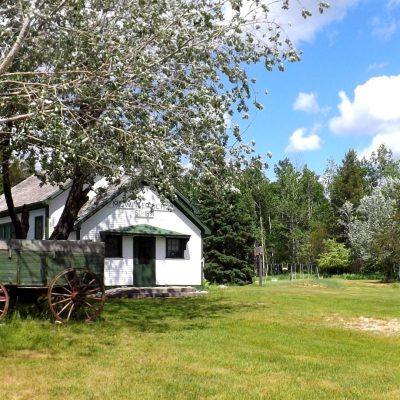

Our Historical Treasures: Then and Now
Scattered throughout Eastern Manitoba are museums and historical sites offering an inside look of days on by, of the monumental moments that helped shape the Region and Province. Explore our past with our historical treasures and discover their beginnings.
Feature Image of Midwinter School Heritage Site
Fort Dufferin (Emerson)
Before we dive into Fort Dufferin’s fascinating story, we want to say you HAVE to visit the site on September 25, 2022, for their annual Heritage Days. Heritage Days is celebrating the 150th anniversary of the Boundary Commission marking the Canada/US border! Fort Dufferin was used as their headquarters back in 1872.
Fort Dufferin Then:
From 1872 to 1874, the Fort Dufferin site served as the headquarters for the British-Canadian contingent of the International Boundary Commission as they mapped out the 49th parallel. Assembling here was the newly-formed Northwest Mounted Police for their march towards the West – to what is now Alberta.
From 1875 to 1879, Fort Dufferin was an immigration station where over 18,000 people landed to start their journey to the West. Fort Dufferin’s role as an immigration station lasted only as long as boats on the Red River were the main transport mode for immigrants to Manitoba. The property subsequently served as a livestock quarantine station before being sold to private owners and then finally to the Province of Manitoba.
Fort Dufferin became a National Historic Site in 1999 and is maintained by the Post Road Heritage Group with the Municipality of Emerson-Franklin’s assistance.
Fort Dufferin Now:
Today, one of the buildings that once sat at the site still exists. A monument at the entrance to this site, near Emerson in the Municipality of Emerson-Franklin, bears two plaques. One plaque, erected in 1997 by the Historic Sites and Monuments Board of Canada, describes the westward march of the Northwest Mounted Police. The other plaque commemorates two constables in the force, W. C. Brown and A. McIntosh, who died in 1874 at Fort Dufferin and are buried in unmarked graves near the site.
What used to be the Fort Dufferin quarters is now the interpretive centre that holds artifacts and informational displays. There is now a maintained walking trail on-site where you can take in the scenic sights and end up by the banks of the Red River, where you can cast your line and catch a few Catfish.
Recently, the Post Road Heritage Group has announced the construction of a new building on site! Construction has started on the Officers’ Mess Kitchen as a recent donation of $31,500 came in from the Province of Manitoba through the “Building Sustainable Communities Program.”
Historic Manitoba Glass Works Factory (Beausejour)
Historic Manitoba Glass Works Factory Then:
Construction of the Manitoba Glass Works began in June 1906 in Beausejour by Joseph Keilbach and his partners Gustav Boehm, Edward Keilbach, and Carl Keilbach. It was the first glass container factory in Western Canada. By October 1906, the facility was operational, and then, in January 1907, it was incorporated.
Glass-blowers from Poland and the United States, aided by local labour, used silica sand to produce bottles for breweries and soft drink companies in Winnipeg, serving the prairie market. By 1907, the plant produced 15,000 to 20,000 bottles per week. Later, between 1909 and 1911, new semi-automated equipment was installed to enable the production of jars and medicine and ink bottles. At its peak, the firm employed 350 workers.
Unfortunately, the factory could not compete with larger manufacturers in Eastern Canada who held the exclusive license for fully automatic machines. The Beausejour Works was closed by 1914 but was purchased by a Montreal company that relocated its operations to Redcliff, Alberta, in response to an offer of free natural gas and land.
Historic Manitoba Glass Works Factory Now:
Today, the Historic Manitoba Glass Works Factory is a provincially-designated historic site and can be enjoyed by all. While no buildings remain at the site, the concrete foundations can still be seen, and glass pieces can be found.
Explore the ruins of the first glass container factory in Western Canada and see what treasures you can discover while taking in this intriguing site. Nearby is the entrance to Chryplywy Nature Park, which promises a peaceful hike.
Midwinter School Heritage Site (East Braintree)
Midwinter School Heritage Site Then:
Midwinter School was formally organized in June 1917 and was a one-room school building erected on property donated by Charles Midwinter, a Winnipeg City Councilor. The seven acres parcel of land was situated along the Boggy River in East Braintree. The facility was built on the southeast quarter of 4-8-14 east of the Principal Meridian, later becoming the Rural Municipality of Reynolds.
The School House closed in 1968 when rural schools became consolidated. It was then bought by Glenn, McMunn and East Braintree communities and later, it became a Regional Heritage Site in 1989 and a National Heritage Site in 2010.
The school building was also once used as a community place, a dance hall, a church, a bingo hall, and community 4H meetings and fairs.
Midwinter School Heritage Site Now:
With the help of volunteers, this century-old building has aged beautifully. Now a museum, you can visit this site and immerse yourself in old memorabilia of the days gone by, explore the numerous antique items and artifacts, and changing exhibits.
Regular Museum Hours are Saturdays from 2 PM to 4 PM and Sundays from 1 PM to 5 PM in July and August. They offer guided group and school tours year-round by appointment (at least 48 hours notice). Lunch and refreshments can also be served with 48 hours notice.


